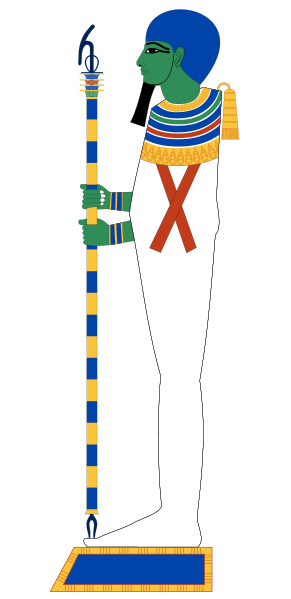

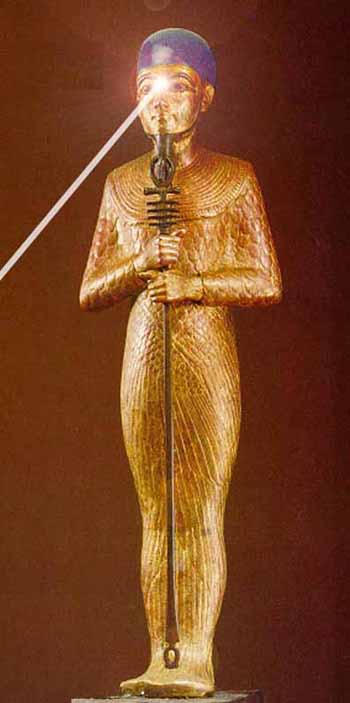
Amphibious Gods
Ptah fashioned the universe through harmonics and thought. He helped the dead on their travels through the afterlife allowing them to transform into his divine figure. He allowed the dead to be like the living after death with the Opening of the Mouth ceremony. The Apis bull was his sacred animal, more of a representation of his soul on earth who gave fertility and rebirth to the people.
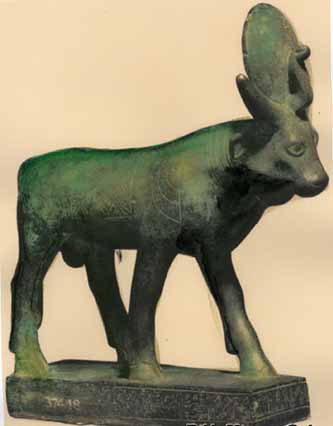
The bull's main sanctuary was near the temple of Ptah in Mennefer, near the bull's embalming house where he became linked to Osiris after death. Herodotus wrote that the Apis bull was conceived from a bolt of lightning, it was black with a while diamond on his forehead, the image of a vulture on his back, double hairs on his tail and a scarab mark under his tongue. The lightning was thought by the Egyptians to be Ptah in the form of a celestial fire, who mated with a heifer. With a creation god as his father, the bull was believed to be a fertility symbol. The heifer that produced the bull was venerated as a form of the goddess Isis. There was only one Apis bull at a time, and the cult of the Apis bull started at the beginning of Egyptian history. While alive, the bull was known as the 'Spokesman' of Ptah and his 'Glorious Soul'.
Ptah was worshipped throughout all of Egypt, his cult centers were Memphis and Heliopolis.
In Egyptian mythology, Ptah (also spelt Peteh) was the deification of the primordial mound in the Ennead cosmogony, which was more literally referred to as Ta-tenen (also spelled Tathenen), meaning risen land, or as Tanen, meaning submerged land.
It was said in the Shabaka Stone, that it was Ptah who called the world into being, having dreamt creation in his heart, and speaking it, his name meaning opener, in the sense of opener of the mouth. Indeed the opening of the mouth ceremony, performed by priests at funerals to release souls from their corpses, was said to have been created by Ptah. Atum was said to have been created by Ptah to rule over the creation, sitting upon the primordial mound.
In Memphis, Ptah was worshipped in his own right, and was seen as Atum's father, or rather, the father of Nefertum, the younger form of Atum. When the beliefs about the Ennead and Ogdoad were later merged, and Atum was identified as Ra (Atum-Ra), himself seen as Horus (Ra-Herakhty), this led to Ptah being said to be married to Sekhmet, at the time considered the earlier form of Hathor, Horus', thus Atum's, mother.
Since Ptah had called creation into being, he was considered the god of craftsmen, and in particular stone-based crafts. Eventually, due to the connection of these things to tombs, and that at Thebes, the craftsmen regarded him so highly as to say that he controlled their destiny. Consequently, first amongst the craftsmen, then the population as a whole, Ptah also became a god of reincarnation. Since Seker was also god of craftsmen, and of reincarnation, Seker was later assimilated with Ptah becoming Ptah-Seker.
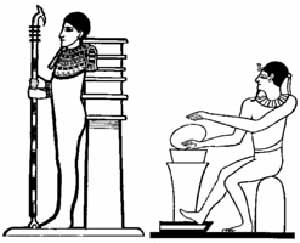
Ptah-Seker gradually became seen as the personification of the sun during the night, since the sun appears to be reincarnated at this time, and Ptah was the primordial mound, which lay beneath the earth. Consequently, Ptah-Seker became considered an underworld deity, and eventually, by the Middle Kingdom, become assimilated by Osiris, the lord of the underworld, occasionally being known as Ptah-Seker-Osiris.
The origin of Ptah's name is unclear, though some believe it to mean 'opener' or 'sculptor'. As a god of craftsmen, the later is probably correct. He was a patron of the arts, protector of stonecutters, sculptors, blacksmiths, architects, boat builders, artists and craftsmen. His high priest was given the title 'Great Leader of Craftsmen', and his priests were probably linked to the different crafts.
Ptah's importance may be discerned when one learns that "Egypt" is a Greek corruption of the phrase "Het-Ka-Ptah," or "House of the Spirit of Ptah."
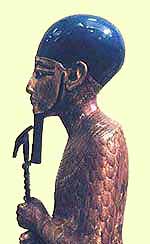
In art, he is portrayed as a bearded mummified man, often wearing a skull cap, with his hands holding an ankh, was, and djed,, the symbols of life, power and stability, respectively. It was also considered that Ptah manifested himself in the Apis bull.
In the Memphite theology, Ptah is the primal creator, the first of all the gods, creator of the world and all that is in it. He is the artificer, the creator god, according to the priests of Memphis, the ancient capitol of Egypt. Ptah is not created, but simply is.
The Egyptians believed that Ptah was a god who created everything from artifacts to the world egg to the other deities themselves. The Opening of the Mouth ceremony was believed to have been devised by him.
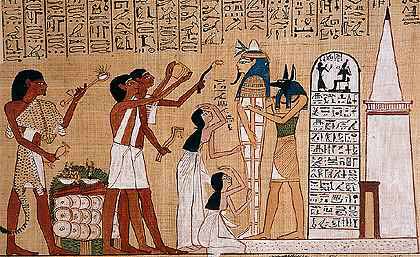
When an ancient Egyptian died, he was not buried into the ground, mourned and then forgotten. Nor was his grave simply visited at certain times and some token words spoken over it, so that once again he is forgotten until next visit. The ancient Egyptians believed that ritual existed which would bring sensory life back to the deceased's form, enabling it to see, smell, breathe, hear, and eat, and thus partake of the offering foods and drinks brought to the tomb each day.
Priests would recite hymns such as this one, for Pa-nefer:
Once the deceased was rejuvenated back with all his senses, he could also interact and watch over the family members, affecting their lives. Letters have been found attesting to the continued contact, or at least, belief in the continued contact, between deceased and living. Letters such as this one, from the scribe Butehamun to his deceased wife Ikhtay, where he asks her to intercede with the Lords of Eternity on his behalf. "If you can hear me in the place where you are ... it is you who will speak with a good speech in the necropolis. Indeed I did not commit an abomination against you while you were on earth, and I hold to my behavior."
The Opening of the Mouth ceremony was an important ritual in both funerary and temple practice. It originated as a ritual to endow statues with the capacity to support the living ka, and to receive offerings. It was performed on cult statues of gods, kings, and private individuals, as well as on the mummies of both humans and Apis bulls. It was even performed on the individual rooms of temples and on the entire temple structure.
The effect of the ritual was to animate the recipient (or, in the case of a deceased individual, to re-animate it). The ritual allowed the mummy, statue, or temple, to eat, breathe, see, hear and enjoy the offerings and provisions performed by the priests and officiants, thus to sustain the ka or soul spark - spirit.
The earliest Old Kingdom textual references to the ceremony date to the early 4th dynasty, to the Palermo Stone and the decoration of the tomb of the royal official Metjen. At this time, the ritual seems to have been performed solely to animate statues, rather than to re-animate the deceased.
Ptah was married to either Bast, Sekhmet or Wadjet. His union with Bast was thought to have produced a lion-headed god called Mihos, while Nefertem was his son by either Sekhmet or Wadjet. Different towns believed that Ptah was married to their goddess, and thus the confusion with his family ties. Mennefer had a triad consisting of Ptah, Sekhmet and Nefertem.
The architect of the Saqqara Step Pyramid, Imhotep, after he became deified, came to be regarded as the son of Ptah. As father and creator of the gods, the deities he created first were Nun and Naunet and the nine gods of the Ennead. The nine were Atum, Shu, Tefnut, Geb, Nut, Osiris, Isis, Set, and Nephthys who were considered to be both the teeth and lips of the mouth of Ptah and the semen and the hands of Tem.
He was linked to two other Mennefer gods - Ta-tenen and Sokar. Ta-tenen (known as Ptah-Ta-tenen when the two were combined) was an earth god connected with the primeval mound as it rose from the waters of Nun while Sokar was a god of the necropolis. This reinforced Ptah's aspects of a god of creation and a god of the dead. Ptah-Sokar was also connected with Osiris, and known as Ptah-Sokar-Osiris. Statues of the three-in-one god showed a mummiform man wearing the sun disk, corkscrew ram horns and long plumes or the atef crown. These statues often contained a copy of spells from The Book of the Dead.